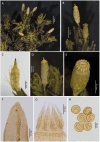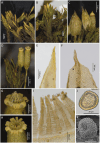Unveiling the diversification and dispersal of the Lewinskya firma complex (Orthotrichaceae, Bryophyta) across Africa and India
- PMID: 39399544
- PMCID: PMC11466771
- DOI: 10.3389/fpls.2024.1451005
Unveiling the diversification and dispersal of the Lewinskya firma complex (Orthotrichaceae, Bryophyta) across Africa and India
Abstract
Intercontinental disjunctions are one of the most attractive and interesting biogeographical patterns. Bryophytes often exhibit such distributions, which is partly explained by their great ability to disperse over long distances. However, such intercontinental ranges are sometimes a distorted reality caused by the existence of unnoticed species. This study investigates whether the disjunction between East Africa and southern India of the moss Lewinskya firma reflects the genuine distribution of a single species or implies pseudo-cryptic species (whose morphological differentiation is subtle and have therefore been masked). An integrative taxonomic approach combining morphological and molecular methods (genotyping by sequencing, GBS) was used, based on a representation of samples specifically collected from all the major mountainous regions where this moss occurs. Two species, L. firma s. str. and L. afroindica sp. nov. are involved, whose ranges completely overlap in East Africa, although genetic distance and morphological differences in leaf apex shape, vaginula hairs shape and papillosity, spore ornamentation and peristome constitution and ornamentation allow distinguishing both. In addition, the range of L. afroindica extends into both southern Africa and southern India. The phylogenetic reconstruction obtained shows a certain degree of differentiation of the Indian populations, although they are yet morphologically indistinguishable from African populations. The results thus highlight both the existence of overlooked species and the complexity of bryophyte biogeography.
Keywords: Orthotrichum firmum; biogeography; intercontinental disjunction; mosses; speciation; taxonomy.
Copyright © 2024 Lara, Díaz San Román, Fernández-Mazuecos, Calleja, Flagmeier, Mazimpaka, Garilleti and Draper.
Conflict of interest statement
The authors declare that the research was conducted in the absence of any commercial or financial relationships that could be construed as a potential conflict of interest. The handling editor MTB declared a past co-authorship with the author JACA.
Figures






Similar articles
-
Do mosses really exhibit so large distribution ranges? Insights from the integrative taxonomic study of the Lewinskya affinis complex (Orthotrichaceae, Bryopsida).Mol Phylogenet Evol. 2019 Nov;140:106598. doi: 10.1016/j.ympev.2019.106598. Epub 2019 Aug 17. Mol Phylogenet Evol. 2019. PMID: 31430552
-
Need for split: integrative taxonomy reveals unnoticed diversity in the subaquatic species of Pseudohygrohypnum (Pylaisiaceae, Bryophyta).PeerJ. 2022 Apr 26;10:e13260. doi: 10.7717/peerj.13260. eCollection 2022. PeerJ. 2022. PMID: 35497188 Free PMC article.
-
The long journey of Orthotrichum shevockii (Orthotrichaceae, Bryopsida): From California to Macaronesia.PLoS One. 2019 Feb 13;14(2):e0211017. doi: 10.1371/journal.pone.0211017. eCollection 2019. PLoS One. 2019. PMID: 30759110 Free PMC article.
-
Vegetative and reproductive innovations of early land plants: implications for a unified phylogeny.Philos Trans R Soc Lond B Biol Sci. 2000 Jun 29;355(1398):769-93. doi: 10.1098/rstb.2000.0615. Philos Trans R Soc Lond B Biol Sci. 2000. PMID: 10905609 Free PMC article. Review.
-
Bryophyte diversity and evolution: windows into the early evolution of land plants.Am J Bot. 2011 Mar;98(3):352-69. doi: 10.3732/ajb.1000316. Epub 2011 Feb 25. Am J Bot. 2011. PMID: 21613131 Review.
References
-
- Alonso A., Gallego-Narbón A., Coca-de-la-Iglesia M., Monjas D., Medina N. G., Fernández-Mazuecos M., et al. . (2022). Climatic niche pre-adaptation facilitated island colonization followed by budding speciation in the Madeiran ivy (Hedera maderensis, Araliaceae). Front. Plant Sci. 13. doi: 10.3389/fpls.2022.935975 - DOI - PMC - PubMed
-
- Brinda J. C., Atwood J. J. (2023). “A synopsis of Orthotrichaceae,” in The bryophyte nomenclator. Available at: https://www.bryonames.org/nomenclator?group=orthotrichaceae.
LinkOut - more resources
Full Text Sources
Miscellaneous

